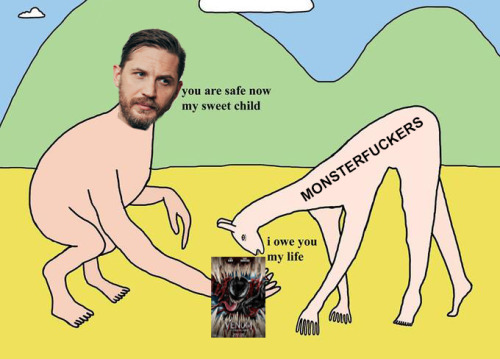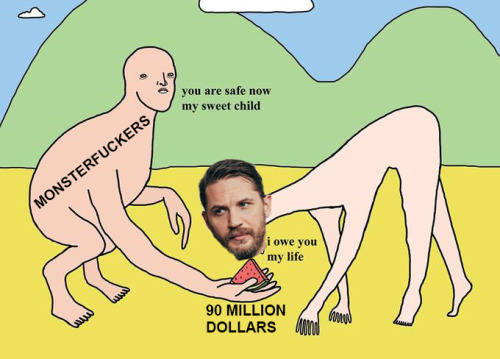I’d Like To Remember The Names Of Cool People And Amazing Things But My Memory Is A Bloody Sieve And
i’d like to remember the names of cool people and amazing things but my memory is a bloody sieve and i have zero control over what gets to stay in there
More Posts from Badweatherbartender and Others
it's not that I need a quiet day or a day off exactly; it's that I need a pocket of time that exists entirely outside of linear time as we know it that would allow me to get things done without time passing in the real world, and frankly, I don't think that's too much to ask.
domming for a werewolf that takes notes for you...makes him your lycan sub scribe.
how to counterspell when you're not a caster
Rogue: That spell that [NPC Sorcerer] is about to cast on me requires concentration, right?
GM: It does.
Rogue: I take off my shirt.




Congratulations to Tom Hardy on being the only man in Hollywood to figure out that if he makes us our gay little content, we're gonna give him our gay little money.
Yellowjacket-Mimicking Moth: this is just a harmless moth that mimics the appearance and behavior of a yellowjacket/wasp; its disguise is so convincing that it can even fool actual wasps

This species (Myrmecopsis polistes) may be one of the most impressive wasp-mimics in the world. The moth's narrow waist, teardrop-shaped abdomen, black-and-yellow patterning, transparent wings, smooth appearance, and folded wing position all mimic the features of a wasp. Unlike an actual wasp, however, it does not have any mandibles or biting/chewing mouthparts, because it's equipped with a proboscis instead, and it has noticeably "feathery" antennae.
There are many moths that use hymenopteran mimicry (the mimicry of bees, wasps, yellowjackets, hornets, and/or bumblebees, in particular) as a way to deter predators, and those mimics are often incredibly convincing. Myrmecopsis polistes is one of the best examples, but there are several other moths that have also mastered this form of mimicry.

Above: Pseudosphex laticincta, another moth species that mimics a yellowjacket
These disguises often involve more than just a physical resemblance; in many cases, the moths also engage in behavioral and/or acoustic mimicry, meaning that they can mimic the sounds and behaviors of their hymenopteran models. In some cases, the resemblance is so convincing that it even fools actual wasps/yellowjackets.

Above: Pseudosphex laticincta
Such a detailed and intricate disguise is unusual even among mimics. Researchers believe that it developed partly as a way for the moth to trick actual wasps into treating it like one of their own. Wasps frequently prey upon moths, but they are innately non-aggressive toward their own fellow nest-mates, which are identified by sight -- so if the moth can convincingly impersonate one of those nest-mates, then it can avoid being eaten by wasps.

Above: Pseudosphex laticincta
I gave an overview of the moths that mimic bees, wasps, yellowjackets, hornets, and bumblebees in one of my previous posts, but I felt that these two species (Myrmecopsis polistes and Pseudosphex laticincta) deserved to have their own dedicated post, because these are two of the most convincing mimics I have ever seen.

Above: Pseudosphex sp.
I think that moths in general are probably the most talented mimics in the natural world. They have so many intricate, unique disguises, and they often combine visual, behavioral, and acoustic forms of mimicry in order to produce an uncanny resemblance.
Several of these incredible mimics have already been featured on my blog: moths that mimic jumping spiders, a moth that mimics a broken birch twig, a moth caterpillar that can mimic a snake, a moth that disguises itself as two flies feeding on a pile of bird droppings, a moth that mimics a dried-up leaf, a moth that can mimic a cuckoo bee, and a moth that mimics the leaves of a poplar tree.
Moths are just so much more interesting than people generally realize.
Sources & More Info:
Journal of Ecology and Evolution: A Hypothesis to Explain Accuracy of Wasp Resemblances
Entomology Today: In Enemy Garb: A New Explanation for Wasp Mimicry
iNaturalist: Myrmecopsis polistes and Pseudosphex laticincta
Transactions of the Entomological Society of London: A Few Observations on Mimicry
I really hate a lot of the advice on the Internet about taming birds.
So much of it is literally "isolate your birds so they bond to you instead of each other" or "clip your bird's wings so it can't get away from you when it feels nervous." I'm no expert, but that's fucked up, man.
"Best I can do is worms"
- our warlock, about to cast Infestation
My favorite detail about Jurassic Park is that it has a baked-in justification for any and all retcons it might need to make due to paleontology advancing forwards.
Because there is not a single dinosaur that has ever appeared in Jurassic Park.
Not one. Not in the books. Not in the movies. Not ever.
"Now what John Hammond and InGen did at Jurassic Park was to create genetically engineered theme park monsters." ~Alan Grant
Grant says that in a moment of cynicism. It's part of his arc for the film. But it's not inaccurate. What Jurassic Park has, what it's always had since the very first novel, are "Mostly Dinosaurs".
"And since the DNA is so old, it's full of holes! Now, that's where our geneticists take over!" ~Mr. DNA
It's impossible to recover a fully intact gene sequence from an ancient amber mosquito. Cloning a pure dinosaur would have been completely impossible, and so the park filled in the gene sequence with whatever works. Frog. Lizard. Bird. Whatever they need to get the result they are trying to get.
Every single dinosaur is a chimeric beast made up of mostly dinosaur and a bunch of other stuff that some scientists thought would achieve the appropriate dinosaur-like result.
"Nothing in Jurassic World is natural! We have always filled gaps in the genome with the DNA of other animals. And if the genetic code was pure, many of them would look quite different." ~Dr. Henry Wu
Which, from a writing perspective, is fucking genius. Because now you have a preset excuse for each and every plot hole your movie has.
Like. Why don't the raptors have feathers? Because of the chimera DNA.
Why do dilophosaurs spit venom? Because of the chimera DNA.
Why do T-Rexes have movement based vision? Oh, they don't. But Rexy does. Because of her chimera DNA.
Why is the Spinosaurus so fucking big? Because of the chimera DNA.
Why are the velociraptors mislabeled? Because Hammond's a dipshit.
Like. I've always marveled at the way Jurassic Park started out by giving itself a blanket excuse to be wrong about every single thing it ever said about the central attraction of its franchise. It's honestly beautiful, and allows the series a degree of immortality well into the era where we know better about its animals.

Dear everyone who is currently working on a Thing, whatever that Thing may be,
Good luck with the Thing. You can do the Thing. You will do the Thing. You just have to do the Thing.
Best wishes,
Someone who is also doing a Thing
-
 badweatherbartender reblogged this · 3 years ago
badweatherbartender reblogged this · 3 years ago
